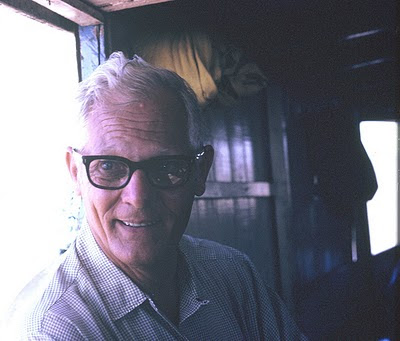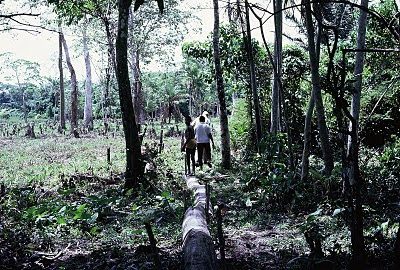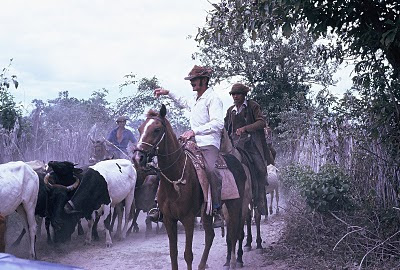Bill Mosely was the first missionary I ever worked with. Having been reared Jewish, my only knowledge of the profession before meeting him came from reading W. Somerset Maugham’s “Rain” and books and films that tended to demonized or ridiculed the calling. So you can understand the slight trepidation I felt as I approached him for the first time that day in the Fortaleza airport. He managed to shatter my stereotyped misconceptions in a matter of minutes.
At first glance, seeing his tall, lean, slightly bent body and pale complexion, I took the man to be frail. Nothing could have been farther from the truth. Bill Mosely was, in fact, a man of unexpected physical resilience. He bounced in and out of trucks and boats with the agility of an athlete, and could sleep at the drop of a hat, waking moments later completely refreshed and ready to go. Another surprise: While deeply committed to his work, he was not, as I had anticipated, rigid or narrow, and certainly not humorless. He had a keen intellect, an active curiosity, and a wry sense of humor for which, during our time together, I seemed to provide inexhaustible fodder. Let me give you an example.
The film we were making was about how a handful of Brazilian Presbyterians, with some financial help from like-minded Christians in the United States, were helping families rescued from the drought devastated sertão get a new start in the developing area along the Amazon River. Cattle played an important part in the story—the Sindhi cattle that had been brought to Brazil from India because they could survive in an area that was often under water. Before the crew came, Bill and I scouted out a cattle ranch to arrange a “shoot” there. It was on an island which was often submerged and never completely dry. To get around one had to balance on logs laid down as a path.
During our visit, as I was trying to maneuver on one of these log paths, my foot slipped, sinking ankle-deep into a messy mixture of mud and cow paddies. (For the uninitiated, cow paddies is a polite name given to what comes out of the rear end of cattle.) Seeing my dismay, Bill suggested I go down to the river and dip my foot in to clean off the mud and “other stuff.” He waited until my foot was completely submerged and then called out, “And watch out for the Piranhas!” which extracted from me the exact panicked reflex reaction he was looking for. (Just as a point of interest, children were swimming in the river at the time unconcerned because, as I learned later, while the type of Piranhas in the area would eat chickens or cow parts, Homo sapiens are apparently not on their menu.)
Since we spent a great deal of time on the slow-moving dirt road that would eventually become the Trans Amazonian Highway... shuttling back and forth between Fortaleza and the primitive compounds in the heart of the Rain Forest, Bill and I had plenty of time to get to know each other. He may have been my first missionary, but I was his first Jew, and we were not shy in satisfying our curiosity about each other.
I learned that Bill had been in Brazil since 1945 and, as rugged as I felt the area was at the time, it was even rougher in his early years. The terrain and hostile Indians in the interior were not the only dangers he faced. Evidently the Catholic Priests saw the infidel Presbyterian Missionaries as a threat to their congregations. Bill recounted how, in the early years, it was not unusual for him to be run out of a village by stone throwing men, led by their village priest. However, that was a long time ago, he insisted; ecumenical relations were better now (1972).
How the Presbyterians came to be in Brazil is in itself an interesting tale. At least in the version of the story I got from Bill. It seems that after the Civil War, a number of Southern families, finding the idea of living in a country where Blacks were viewed to be on an equal social footing with Whites untenable, fled to Brazil. It was these expatriates, desiring spiritual guidance, who requested the Presbyterian Church send missionaries for their communities. What amused Bill most about the story was that in less than a decade, these same former Americans had begun to intermarry with the “brown” people of Brazil—the offspring of the union of European and Indian and yes...former slaves.
If I had been able to hand pick my guide during the weeks I spent in Brazil, I could not have found a more knowledgeable, companionable or enjoyable escort. When it came time to part Bill, after a slight hesitation, bent down and hugged me. With a wry smile, he shook his head and said, “It’s a shame.”
"What’s a shame?" I asked.
“You would have made a good Presbyterian,” he said.







Interesting story - I didn't know you made this trip when you were still living in Hollywood. Hope all is well.
ReplyDelete